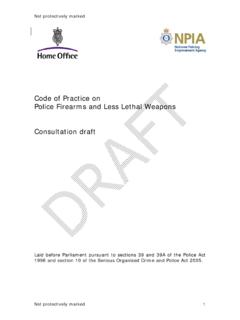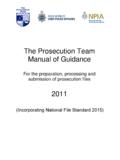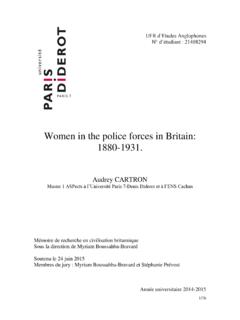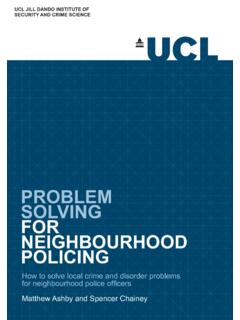Transcription of The effects of Hot-Spot Policing on Crime
1 What Works Briefings were superseded in 2015 by the Crime Reduction Toolkit This document is held by the National Police Library for archival purposes. The effects of Hot-Spot Policing on Crime : What Works Briefing Last updated September 2013. Summary Hot spots Policing is an effective Crime reduction strategy, but only modestly. Hot spot Policing works best for drug offences, violent Crime and disorder, while it was less effective (but still had some positive effect ) for property crimes What is a what works' briefing? more technical report that trawls for all available evaluations of the Policing of hot spots' ( hotspotting') and summarises This briefing has been developed by researchers from the findings from only those experiments that have high quality College of Policing to summarise the best available' evidence methodologies. The review then drew general conclusions in relation to the effects of Hot-Spot Policing on Crime and to from this pool of evaluations about how well hot spots highlight the implications for police policy and practice.
2 This Policing worked in relation to reducing Crime , compared to document briefly summarises two Campbell Collaboration areas with similar problems where these tactics were not 0. Systematic Reviews12. A systematic review is a longer and employed. Read the full review: click on link 1. Braga, AA. The effects of hot spots Policing on Crime . Campbell Systematic Reviews 2007:1. 2. Braga, AA., Papachristos, A. and Hureau, D. Hot spots Policing effects on Crime . Campbell Systematic Reviews 2012:8. 1 8. What is hotspotting'? Crime and disorder is not evenly spread across areas and Policing should be concentrated in the areas of greatest demand. Studies have also shown that Crime is significantly clustered at a much smaller geographic level in Crime hotspots'. Sherman et al. (1989), for example, found that half of all calls made by the public to the police in Minneapolis came from less than percent of addresses.
3 Hot-Spot Policing ( hotspotting') aims to identify locations where Crime and disorder (and possibly other types of problems) are most prevalent and take law enforcement action in those areas as a deterrent. Hotspotting'. involves the careful analysis of patterns of Crime , thus enabling police to target their response where it is needed most. Two key characteristics of hot spot Policing are: The lack of proper lighting, an abundance of stash . locations around the derelict property, and a steady flow 1. Hot spots Policing is geographically focused: the of potential customers on the thoroughfare, creates an location of Crime rather than the features of criminals environment conducive to drug dealing. are central to the strategy. Hot spots Policing is informed in part by environmental criminology, where the 2. Hot spots Policing has tended towards a narrow law characteristics of an area or place are viewed as key in enforcement' approach to the problems identified, even explaining clusters of criminal events.
4 The review gives when problem-oriented approaches have been used. The the example of how a combination of a poorly lit street review distinguished three types of Hot-Spot response, each corner with an abandoned building, located near a major progressively more aggressive' in its tactics, these were thoroughfare, provides an ideal location for a drug market. enforcement based POP', directed aggressive patrol', and crackdowns'. Hotspotting' has affinities with problem . oriented Policing ' (POP) in the way it uses analysis and intelligence to identify problems. However, true POP interventions typically involve more than an enforcement-only response often involving partnerships and community cohesion interventions. However, more recent studies (Braga and Bond, 2008) have used a broader based problem-oriented approach to addressing Crime hot 7 spots. 2 8. Identifying hot spots Hot spots Policing focuses on localised problems below the neighbourhood or community level.
5 The target areas for hot spot Policing assessed by this review were high activity Crime places' - not entire neighbourhoods or communities with elevated rates of Crime . Examples of places could include stores, homes, apartment buildings, street corners, and train stations. Hot spot Policing seeks to address Crime and disorder at specific locations such as these, not wider geographical areas. Successful interventions examined in the review identified hot spots on the basis of calls made by the public relating to Crime and disorder. Areas with elevated levels of complaints were identified by analysts from this call data. Hot spots can therefore be identified through analysis of call data, but this can be helpfully contextualised by the local knowledge of officers about the area in question. The review mentioned the example of a particular street having a high number of calls related to disorder because it is a route home from a nightclub.
6 Call data alone cannot provide this contextual information. When analysis is supported by the local knowledge of officers, hotspots are most effectively identified and understood. Does it work? Doesn't Crime just move elsewhere? Yes it does, modestly. Hot spots Policing programs generate Policy makers worry that forceful police action to suppress modest Crime control gains and are likely to produce a Crime and disorder in one location simply displaces the diffusion of Crime control benefits into areas immediately problem to adjacent areas (displacement effect ). In fact, surrounding targeted high-activity Crime places3. However, it evidence suggests a mirror image of this, the diffusion is not a cure all for Policing problems. The review found that effect . Instead of adjacent areas suffering from displaced hot spot Policing worked best for drug offenses, violent Crime Crime , the benefits of police action have a positive knock- and disorder, while it was less effective (but still had some on' effect beyond the immediate area of the intervention.)
7 Positive effect ) for property crimes. A previous review4 by the Monitoring surrounding areas for evidence of displacement same author concluded that hot spot Policing worked best for and diffusion is advisable following hot spots interventions. disorder ( loitering, public drinking, solicitation), but was This monitoring needs to be long term, not just a few weeks of limited use in dealing with violent offences. The difference after the intervention 7 in conclusion in relation to violent Crime may be partly due to the different interventions that were deployed with hot spots ( POP or increased Policing ) or the study methodology (randomised experiment or quasi experimental). 3. Braga, AA., Papachristos, A. and Hureau, D. Hot spots Policing 3 8 4. effects on Crime . Campbell Systematic Reviews 2012:8. Braga, AA. The effects of hot spots Policing on Crime . Campbell Systematic Reviews 2007:1.
8 What type of interventions work best at hotspots While different types of Hot-Spot interventions ( enforcement based POP', directed aggressive patrol', and crackdowns') all appeared to be effective, POP. generated larger Crime reduction effects . POP appeared particularly effective with property crimes and disorder. However, it cannot be concluded from the reviews which type of police response is most appropriate for particular circumstances, or whether any of the police responses used in these projects are equally effective. How does hot spots Policing affect the There is evidence outside the review that residents of areas subjected to hot spots Policing welcome the concentration public? of police efforts (Shaw 1995), however other studies found The effects of hot spot strategies on public perceptions focused aggressive police enforcement strategies resulted of the police are unclear.
9 The Review was unable to draw in increased citizen complaints about police misconduct any conclusions about the effect of police action on local and abuse of force (Greene 1999). The potential impacts of residents and regular users of the area, because only three enforcement-based hot spots Policing on police legitimacy of the evaluations collected this data. However, these three may depend in good part on the specific strategy used evaluations revealed the community members had positive and the social context of the hot spots affected. It is worth opinions and experiences when subjected to hot spots remembering that while aggressive stop and search Policing initiatives. ( crackdowns') may suppress Crime , if it does so at the expense of sacrificing the good will of law abiding citizens, then this can have longer term adverse consequences. 7. 4 8. Implications for good practice Accurate and complete call data is vital.
10 It is crucial to identify as clearly as possible the existence of hotspots and the source of the heat, otherwise it becomes a blanket response to an undefined problem. Some studies had severe problems identifying hotspots because calls were not properly logged with for example, some problem properties having calls logged to several addresses because the building faced onto two roads. This meant the real scale of the problem was not identified. This emphasises the need to supplement purely statistical analysis with the local knowledge of patrol officers, who are more likely to know the areas they patrol and connect the dots on the map more intelligently. Regular police presence at hot spots can have a lasting A recent study from the US, for example, has found that while effect on Crime and disorder. The Campbell Review does not intensive police patrols in hotspots delivered short-term but mention it, but it is worth drawing attention to the Koper unsustainable reductions in Crime , the effect of problem- curve' (Koper 1995), based on 5000 hours of close observation solving on Crime was greater and longer lasting (Taylor et of how long it took from a marked patrol car leaving a al.)




